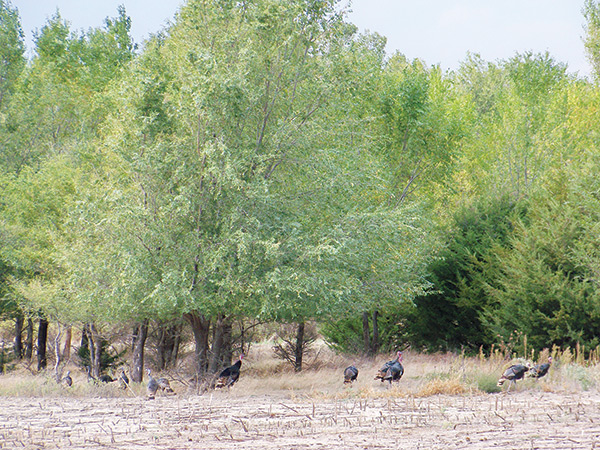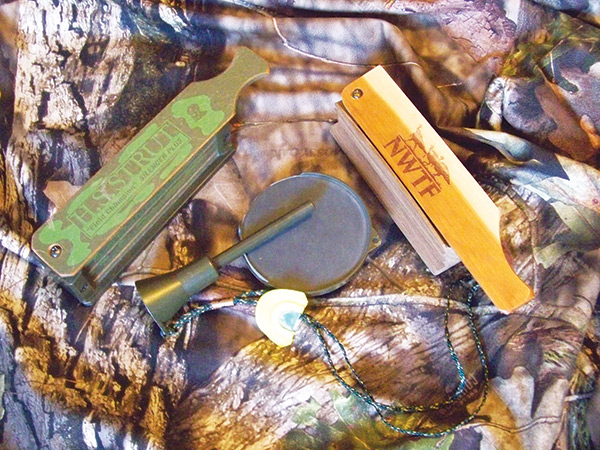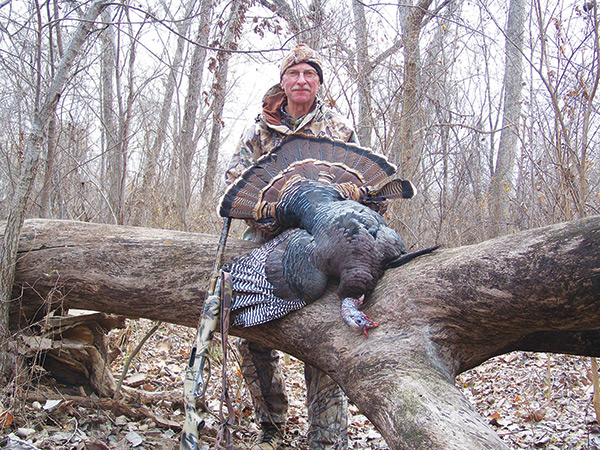 Hunting: Calling Fall Gobblers
Hunting: Calling Fall Gobblers
By Ron Peach

Early October sunshine was filtering through the woods, chasing away the morning chill. I was leaning against a big oak tree on a hillside overlooking a large drainage when I made a first series of yelps with a mouth diaphragm call. A few minutes later, when I was about to send out another series, the rustling of feet running through leaves sounded and then quickly grew louder.
My first thought was “deer,” but then I saw two red heads bobbing. They quickly cut the distance and at 60 yards, the turkeys passed behind some big trees. I lined up the barrel and waited. At 30 yards, the pair of one-and-a-half year old gobblers (what I call super jakes) slowed to a stop and began scanning the shadows of the woods. The lead bird fell to the thunder of my 12-gauge. The other disappeared as its alarm putts faded into the woods.
Fall gobblers are considered the most difficult turkeys to call. At this time of year they aren’t chasing hens; they are in pure survival mode. Most are avoiding hens altogether, especially hens with brood flocks. But if you think like a gobbler and consider what they are doing at different times of the day as a season progresses, calling may still put one at the end of your gun barrel.
While older gobblers tend to shun hen yelps, one-and-a-half-year-old gobblers are still in transition, trying to find their place in the woods. Some haven’t yet mixed in with gobbler flocks and are looking for company. This can make them eager to join hens and vulnerable to hen yelps, as were these two. At this same point of the year, flocks of adult gobblers will likely shun the same hen yelps even though they probably would have checked them out in the spring.

It was nearing noon on another early October hunt in the Missouri woods when I heard the scratching and putts of a group of turkeys on the opposite side of a crease in the hills. Assuming it was a brood flock of hens, I made a series of yelps on a slate and with a mouth call. The only response was silence but, a few minutes later, I caught a glimpse through binoculars of a small flock of gobblers moving away, perhaps intentionally avoiding the unseen hens I had mistakenly mimicked
I sat tight for two hours, enjoying the fall colors of the woods, knowing that there was a flock of gobblers in the area. I was drifting off when I again heard a couple of putts. This time, I recognized the deeper pitch of mature gobblers.
Instead of hen yelps, I made a few clucks and putts with a slate call and scratched in the leaves at my side.
The sounds of walking and scratching grew louder behind me. Finally, a dark form emerged to my right, then a second and a third. When the lead bird crossed behind a big oak, I swung my shotgun barrel. As the gobbler stepped from behind the tree at 25 yards, the beads lined up on his head and the gun called out.
While wrapping a tag around that three-year-old’s leg, I replayed the hunt in my mind. My initial mistake had been caused by not knowing my audience, because they were out of sight. After I saw the turkeys, I knew they were gobblers, and as they were returning, I “echoed” their contented calls attempting to pique their interest and also put them at ease.
During the first weeks of the fall season, small mixed flocks of adult gobblers and adult hens that didn’t pull off a nest may at times mix, especially if there are not a lot of other turkeys in the area. They know their group and tend to ignore any interlopers. However, if you know or can find their preferred roosting location and can set up tight to it, a few hen tree yelps and fly-down cackles the following morning may pull in the first curious gobbler off the roost.
That was exactly what I did one morning after two days of hunting one of those small mixed flocks. Each time I located them throughout the day, my hen yelps, putts, purrs and gobbler yelps sent them the other way. After hearing them fly up to roost the second evening, I noted the exact spot and sneaked out. The following morning, I crept through the woods long before dawn and set up right there near the roost.
When the first tree-yelps sounded below me on the hillside, I answered in kind with tree-yelps, just a bit louder. After a fly-down cackle with a mouth call, I heard heavy wing beats to the right. Footsteps in the leaves gave the gobbler away. As his neck stretched looking for the other early riser, a shotgun blast returned silence to the woods—except for the wing beats of the two-year-old expiring in the dry fallen leaves.
Busting or scattering a brood flock can bring quick responses and hunting success because they almost always attempt to reassemble. Busting a flock of adult gobblers typically brings anything but quick success. The adult birds often take their time, reassembling in a somewhat casual manner. If you scatter a flock of gobblers during the day, patience, and subtle gobbler calls are the best tactic. It may be a matter of hours before you get any response. There is one time of day, however, when busting a gobbler flock can lead to quick success, and that’s the following day.
Shadows were quickly filling the quiet early evening woods. Nary a yelp nor any other turkey sounds disturbed the silence of the day’s end. I knew there were turkeys in the area because I had come across fresh scratches earlier that day. Most were large and against trees, fallen logs and stumps—gobbler sign.
I was walking back through the woods in deepening dusk when the stillness was shattered by alarm putts and then wings hitting limbs as turkeys scattered in different directions. I had inadvertently intruded upon the roost of a small group of gobblers and, because they had gone in various directions, it was the best of situations. When a group of gobblers scatters in the evening, they spend the long night alone and are typically eager to regroup the next morning.
I looked for a tree that would make a good setup the following morning and then walked straight out of the woods. In full darkness early the next morning, I carefully found my way back to that tree and the center of the scattered turkeys. As morning light began to chase away the shadows, I sat quietly, waiting patiently for the first sounds.
Just about sunrise, I heard the coarse three-note yelp of a gobbler to my left. After I repositioned, I imitated that three-note yelp with a box call and waited for a response. The wait was short. The bird quickly answered and we carried on a conversation for 15 minutes, his calls growing louder as he cut the distance between us. When a couple of clucks sounded close to my left, I caught movement. The big tom must have been eager for company as he was walking steadily towards the calls he’d been answering.
Then another series of gobbler yelps sounded in the distance to my right, and the closer gobbler turned that way. But it was too late as copper-plated number fives found their mark. I jumped up and rushed over to claim my prize.
Late season in states that offer December and January hunts may see the beginning of another change in the monarchs of the turkey woods. As daylight hours slowly lengthen, their hormone levels also increase. Though they occasionally gobble on the roost throughout the fall, this seasonal change prompts a notable uptick in gobbling. Mating season is still far away, especially in the northern states, and they are still in bachelor groups, yet they are beginning to pay some attention to hens.
Crusted patches of a late-January snow crunched under my boots as I carefully maneuvered through the trees along a river. A long walk had me arriving a bit late, and shooting light found me short of my planned setup site. That’s when the first gobble sounded to my right. Up in the big cottonwoods, I made out the silhouettes of roosted turkeys about 100 yards away. I quickly found a tree to sit against, hoping I had not been heard or seen in the growing light.
After a few minutes and several more gobbles, I used my box call to send out a few clucks. I was not expecting what I heard next: tree yelps and putts from a flock of hens. Gobblers to my right and hens 150 or 200 yards out in front, which way to turn?
When the toms began to pitch down, they were clearly heading for the hens. So, I began to make hen yelps, putts and fly-down cackles with a mouth call, box call and glass and striker, trying to sound like a competing flock of hens. After several minutes of this the woods went quiet, save for the voices of songbirds and snow geese flying overhead.
Another 15 or 20 minutes passed as I sent out a few more hen yelps. Then I saw them across a draw, a dozen gobblers marching in single file, the leader 60 yards out in front. Necks were stretched as they searched for hens.
I lost sight of them as they crossed the draw; I caught sight of them again when one clucked, but now they were angling away from me. Instead of hen yelps, I made a three-note gobbler yelp. That turned them, and they deliberately marched my way. Whenever one of them yelped, I responded in turn.
Just inside of 40 yards, I put the fiber optic sight on the lead bird’s head. The shot echoed through the woods, and a triple-bearded gobbler hit the dirt. Hen calls had pulled that winter flock of gobblers in my direction, and the gobbler yelps had sealed the deal.
Gobblers can seem indifferent to any calling during fall and winter. Consider what their habits should be at that point of the season and listen for their own vocalizations. You just might get their attention with the right call. It doesn’t always work, but with persistence and a bit of luck, I often end up with a gobbler in front of my gun barrel.
